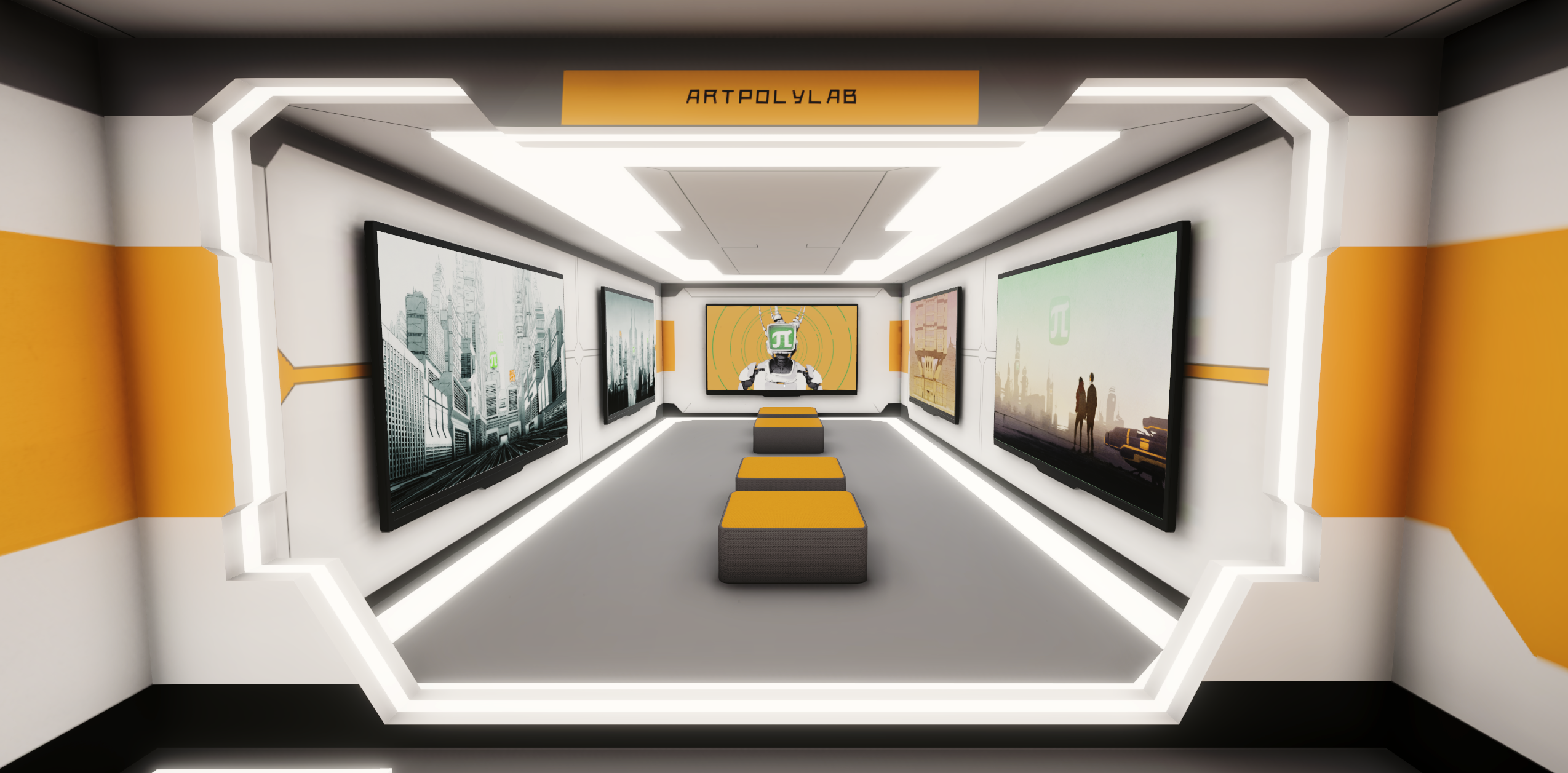Virtual project-oriented art laboratory and exhibition space
Virtual art laboratory and interactive exhibition hall

Task
In 2022, the " SmArt Space of Innovative Multiprofile University (SmArt Campus)" project commenced in SPbPU within the "Technopolis Polytech" strategic and organizational project of the "Priority-2030" programme. It is led by the Institute of Humanities team.
The interdisciplinary SmArt Campus project aims to creatively expand the campus and urban environment through digital technologies based on the confluence of art, education, and science.
One of the SmArt Campus tasks is the creation of ArtPolyLab at the university, both in physical and virtual form. It is designed as a creative workshop for Polytechnic students whose projects are at the intersection of contemporary art, education, and digital technology, and at the same time will serve as an exhibition space for the work of students and faculty.
The physical ArtPolyLab rooms are located in Auditoriums 315 and 317 of the 9th Building at the Institute of Humanities (SPbPU) and was launched in February 2023.
The virtual space is designed to complement and expand the exhibition and functionality of the art lab. There it is planned to place 3D models of exhibits which are impossible or too difficult to demonstrate in physical form, including the works of modern media art. The virtual laboratory should become one of the key components in the testing of various digital tools for the presentation and promotion of students' creativity, master classes, and educational intensives.
The development of the virtual laboratory application and its integration into the SPbPU website is being carried out by the Industrial Systems for Streaming Data Processing Laboratory of the SPbPU NTI Center, which is acting as the technical contractor.
Solution
A digital 3D space for the lab and one of the exhibits has been developed, and the application has been integrated into the SPbPU website.
The interior of the ArtPolyLab was created considering the initial spatial parameters and general design of the art lab in one of the buildings of the Institute of Humanities, SPbPU.
The art lab interior and its first exhibit, a futuristic 3D model of the SPbPU building, were designed by Ivan V. Aladyshkin, Associate Professor of the Social Sciences Department and Deputy Director of the Institute of Humanities of SPbPU.
A desktop version of the application has been developed for the time being. Web and VR versions are scheduled to be completed within 2023 to make it easier for users to access the lab and allow them to move around the virtual room not only by using a keyboard and mouse, but also via VR equipment.
Details
Developing a virtual environment
The virtual environment was created entirely in Unity integrated development environment. Both Unity's built-in tools (prefabs, grid-system, light sources, virtual camera, post-processing components, skyboxes), and third-party assemblies, such as ProBuilder, were used in the development process.
Using the built-in Unity tools in conjunction with suitable third-party assets allows creating the necessary virtual scenes with complex mash geometry, even texture mapping and the required 3D model overlay. What is more, the ability to calculate the lighting at the design stage allows bringing the graphics to a realistic display without loss of arbitrariness at runtime, which is paramount, because the lab will be available both with Desktop and WebGL versions, which implies rendering 3D graphics directly in the browser.
A composite sound system based on Unity AudioMixer has been developed to immerse the user more deeply into the application. To add the presence effect in the virtual room, sound post-processing was set up, simulating the reflection of sound from the walls of the room.
Development of the "Virtual User" software module
This software module is responsible for implementing the following user actions in the application: motion, camera control, interaction sounds and some of the interaction with interactive objects.
In developing the logical component of the module, a component-based approach was used, allowing new changes to be made at little cost. Components were then designed, each responsible for a specific aspect of user behavior.
The user also has physical and logical boundaries - colliders that prevent the user from moving through the objects of the virtual environment.

Virtual User colliders
Technologies
| 3D development environment: | Blender, Substance 3D Painter, Marmoset Toolbag |
| Software engineering environment: | Unity, Visual Studio, JetBrains Rider |
| Software programming languages and frameworks: | С# |
Intellectual Property
Project team
- Project Manager: A.V. Chicherina Ph.D., Associate Professor, Director of the Institute of Humanities, SPbPU
- Project Coordinator: I.V. Aladyshkin D. in History, Associate Professor, Deputy Director, Institute of Humanities, SPbPU
- VR Development Project Manager: M.V. Bolsunovskaya Doctor of Engineering Science, Associate Professor at the Graduate School of Intellectual Systems and Technologies, SPbPU, Head of the Industrial Systems for Streaming Data Processing Laboratory, NTI Center, SPbPU
- Team Lead: A.O. Kuptsov, Programmer of the Industrial Systems for Streaming Data Processing Laboratory, NTI Center, SPbPU
Contractors
- Institute of Humanities, SPbPU
- Industrial Systems for Streaming Data Processing Laboratory, NTI Center, SPbPU




